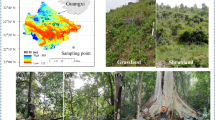Abstract
This study was conducted in the tropical moist deciduous forest in Bangladesh to describe the species composition, diversity, and the forest structure. There were three plots established in Ranishonkoil, Ruhia, and Baliadangi forest beat in Thakurgaon. A total of 126 tree species, 1,991 stems (663 ha−1) of ≥10-cm girth were listed. Tree communities in these forest region differed in dominance, composition, diversity, and structure; and tree stand density varied from 651 to 685 ha−1. Species diversity (H1) ranges from 3.11 to 3.48. Meliaceae, Myrtaceae, and Rubiaceae were the most abundant families within the three plot area. Study site 2 is more diverse at spatial scale and taxonomic levels due to high rainfall and favorable edaphic condition. This study will help the foresters as baseline information for monitoring and sustaining diversity of tropical moist deciduous forests in Bangladesh.
أجريت هذه الدراسة في الغابات الاستوائية الرطبة في بنغلاديش لوصف تكوين الأنواع والتنوع وبنية الغابات . هناك ثلاث قطع أنشئت في غابات Ranishonkoil و Ruhia Baliadangi في ثاكورجاون وقد تم سرد ما مجموعه 126 من انواع الاشجار و 1991 منبع (663 ha−1) التي مقاسها اكبر من او يساوي 10 سم . أختلفت شجرة الانواع في مناطق هذه الغابات من حيث العمومية (الغالبية) و تكوين الانواع والتنوع والتركيب وتراوحت شجرة الكثافة من 651 إلى 685 ha−1. . يتراوح تعدد الانواع (H1) من 311 إلى 348 Meliaceae . وقد وجدت أن أكثر الفصائل هي Myrtaceae و Rubiaceae في المناطق الثلاث . المنطقة الثانية كانت أكثر تنوع على مستوى الانواع ومستوى الانسجة نتيجة سقوط الامطار والظروف الملائمة . سوف تساعد هذه الدراسة مزارعين الغابات كقاعدة معلومات للمراقبة وللمحافظة على تنوع الغابات الاستوائية الرطبة في بنجلاديش


Similar content being viewed by others
References
Ahmed M (1987) Forest exploitation: leading towards disasters. In: Conference on Forest Resources Crisis in the Third World, 6–8 September, 1986. Proceedings of Conference 32–44: Sahabul Alam, Malaysia
Alam M, Furukawa Y, Sarker SK, Ahmed R (2008) Sustainability of Sal (Shorea robusta) forest in Bangladesh: past, present, and future actions. Int For Rev 10:29–37
Alam MK (1988) Annoted checklist of the woody flora of Sylhet forests. Bull. 5, Plant taxonomy series. Bangladesh Forest Research Institute, Chittagong, p 153
Alam MK (1995) Diversity in the woody flora of sal (Shorea robusta) forests of Banngladesh. Bangladesh J For Sci 24(1):41–51
Anonymous Bangladesh Economic Review (2003) Economic Advisers Wing, Finance Division, Ministry of Finance, Bangladesh Secretariat, Dhaka
BBS (2003) Overview: National Series. Bangladesh Population Census, 2001. Ministry of Planning. Government of Peoples Republic of Bangladesh, Dhaka
BBS (Bangladesh Bureue of Statistics) (2006) Ministry of statistics, Ministry of planning, Government of the people’s republic of Bangladesh, pp 12–35
Chaffey DR, Miller FR, Sandom JH (1985) A forest inventory of Sundarbans, Bangladesh. Project 140. Overseas Development Administration, London, p 196
Champion HG, Seth SK (1968) General silviculture for India. Manager of Publications, Delhi, p 511
Cottam G, Curtis JT (1956) The use of distance measurement in phytosociological sampling. Ecology 37:451–460
Das DK (1990) Forest types of Bangladesh. Bulletin 6, Plant taxonomy series. Bangladesh Forest Research Institute, Chittagong, p 9
Dinajpur Forest Division (2007) Dinajpur forest division at a momentary look in Bengali
Hassan MM (1994) Forest soils of Bangladesh. Bangladesh J For Sci 23(2):1–11
Hossain MK (2001) A review of forest biodiversity conservation in Bangladesh. J For Environ 1(1):102–110
Khan MS (1996) National Obligations in the Implementation of the Convention on Biological Diversity: Bangladesh Perspective. A Key Note paper presented at the workshop on the National Obligations in the Implementation of the Convention on Biological Diversity: Bangladesh Perspective at IUCN Bangladesh Country Office, Dhaka
Khan MS, Afza SK (1968) A taxonomic report on the angiospermic flora of Teknaf and St. Martin’s Island. The Dhaka University Studies 16(B):25–30
McCarthy JJ, Canziani OF, Leary NA, Dokken DJ, White KS (eds) (2001) Climate change 2001: impacts, adaptation and vulnerability, intergovernmental panel on climate change (IIPC), Work Group II, Input to the Third Assessment Report. Cambridge University Press, Cambridge
Milde RD, Shaheduzzaman M, Chowdhury JA (1985) The Kassalong and Raikhang Reserve Forests in the Chittagong Hill Tracts, Field Document No. 11, FAO/UNDP Project BGD/79/017, 35pp
Mok ST (1992) Potential for sustainable tropical forest management in Malaysia, Unisylva, 169(43):28–33
Momin MA, Abedin MZ, Amin MR, Islam QMS, Haque MM (1990) Existing homestead plantation and household fuel use pattern in the flood-prone Tangail region of Bangladesh. In: Abedin MZ, Lai CK, Ali MO (eds) Homestead plantation and agroforestry in Bangladesh. BARI, Joydebpur, Bangladesh, pp 136–148
Nath TK, Hossain MK, Alam MK (1998) Diversity and composition of trees in Sitapahar forest reserve of Chittagong Hill Tracts (South) forest division, Bangladesh. Ann For 6(1):1–9
Odum EP (1971) Fundamentals of ecology, 3rd edn. Sounders, Philadelphia
Phillips EA (1959) Methods of vegetation study. Henri Holt Co. Inc
Shannon CE, Wiener W (1949) The mathematical theory of communication. University of Illinois press, Urbana
USAID (1990) Bangladesh: environment and natural resources assessment. Washington DC, USA
Zaman S, Katoh M (2009) Homegarden agroforestry in Bangladesh: an important role occupied for farmers’ income source at Thakurgaon district. J For Plan (Japan) 15(1):37–43
Acknowledgment
The authors show their deep thanks and gratitude to the Japanese Education and Cultural Ministry (MONBUKAGAKSHU MEXT) for the financial support. The authors would like to thank the respondents of the study area, the Department of Agricultural Extension, and the Forest Department of Thakurgaon. The authors also acknowledge Md. Shameem Hassan Bhuiyan, meteorologist, Agrometeorology Division, Bangladesh Meteorological Department for the GIS data of Thakurgaon. We greatly appreciate the anonymous reviewers for their valuable comments, criticisms, and suggestions.
Author information
Authors and Affiliations
Corresponding author
Rights and permissions
About this article
Cite this article
Zaman, S., Siddiquee, S.U. & Katoh, M. Species composition and forest structure in tropical moist deciduous forest of Bangladesh—a case study in Thakurgaon. Arab J Geosci 4, 1315–1321 (2011). https://doi.org/10.1007/s12517-010-0235-x
Received:
Accepted:
Published:
Issue Date:
DOI: https://doi.org/10.1007/s12517-010-0235-x




